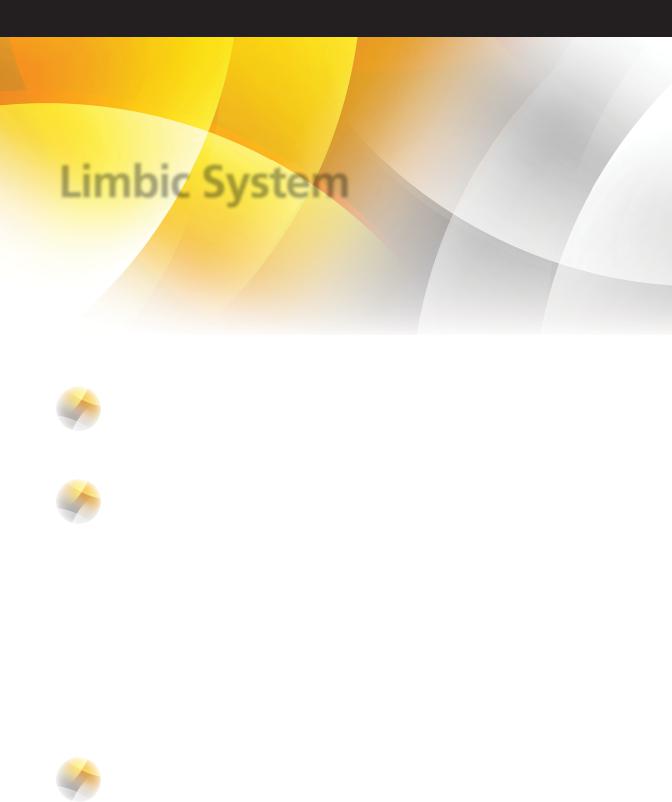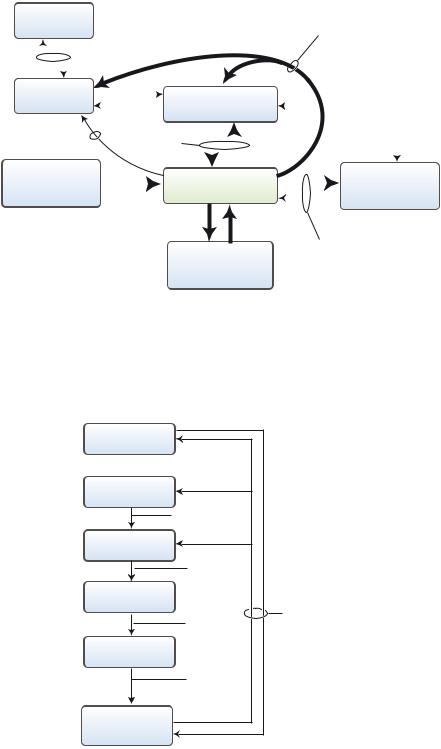
- •Objectives
- •Objectives
- •IX Congenital Malformations of the CNS
- •Objectives
- •VI Regeneration of Nerve Cells
- •Objectives
- •VI Venous Dural Sinuses
- •VII Angiography
- •Objectives
- •Objectives
- •IV Location of the Major Motor and Sensory Nuclei of the Spinal Cord
- •Case 6-1
- •Case 6-2
- •VII Conus Medullaris Syndrome (Cord Segments S3 to C0)
- •Objectives
- •Lesions of the Brainstem
- •Objectives
- •Objectives
- •VII The Facial Nerve (CN VII)
- •Objectives
- •IV Trigeminal Reflexes
- •Objectives
- •Objectives
- •IV Auditory Tests
- •Objectives
- •Objectives
- •VI Cortical and Subcortical Centers for Ocular Motility
- •VII Clinical Correlation
- •Objectives
- •IV Clinical Correlations
- •Objectives
- •Objectives
- •VI Cerebellar Syndromes and Tumors
- •Objectives
- •Objective
- •Objectives
- •I Major Neurotransmitters

|
|
|
|
Visual System |
113 |
A |
|
B |
|
|
|
Flashlight swung from right eye to left eye |
Looking straight ahead |
|
|||
C |
|
|
D |
|
|
Looking right |
Looking left |
Eyes converged |
|
Looking straight ahead |
|
E |
F |
|
|
G |
|
Looking right |
Looking up |
Eyes converged |
|
Looking left and down |
|
H |
|
I |
|
J |
|
No reaction to light |
Eyes converged |
Eyes of a comatose patient |
Looking straight ahead |
|
|
Figure 14-5 Ocular motor palsies and pupillary syndromes. A. Relative afferent (Marcus Gunn) pupil, left eye. B. Horner syndrome, left eye. C. Internuclear ophthalmoplegia, right eye. D. Third-nerve palsy, left eye. E. Sixth-nerve palsy, right eye. F. Paralysis of upward gaze and convergence (Parinaud syndrome). G. Fourth-nerve palsy, right eye. H. Argyll Robertson pupil. I. Destructive lesion of the right frontal eye field. J. Third-nerve palsy with ptosis, right eye.
VI Cortical and Subcortical Centers for Ocular Motility
A.The frontal eye field is located in the posterior part of the middle frontal gyrus (Brodmann area 8). It regulates voluntary (saccadic) eye movements.
1.Stimulation (e.g., from an irritative lesion) causes contralateral deviation of the eyes (i.e., away from the lesion).
2.Destruction causes transient ipsilateral conjugate deviation of the eyes (i.e., toward the lesion).
B.Occipital Eye Fields are located in Brodmann areas 18 and 19 of the occipital lobes. These fields are cortical centers for involuntary (smooth) pursuit and tracking movements. Stimulation causes contralateral conjugate deviation of the eyes.
C.The subcortical center for lateral conjugate gaze is located in the paramedian pontine reticular formation (Figure 14-6).
1.It receives input from the contralateral frontal eye field.
2.It projects to the ipsilateral lateral rectus muscle and through the medial longitudinal fasciculus (MLF) to the contralateral medial rectus subnucleus of the oculomotor complex.
D.The subcortical center for vertical conjugate gaze is located in the midbrain at the
level of the posterior commissure. It is called the rostral interstitial nucleus of the MLF and is associated with Parinaud syndrome (see Figure 14-5F).

114 Chapter 14
Lateral rectus
Left |
Right |
Medial
rectus
Medial rectus subnucleus of CN III
Midbrain
Left MLF |
|
|
|
Right MLF |
|
|
|||
|
|
|
|
Nucleus |
Pons |
|
|
|
of CN VI |
Bilateral MLF syndrome
Left
A
Right
B
Convergence
C
Patient with MLF syndrome cannot adduct the eye on attempted lateral conjugate gaze and has nystagmus in abducting eye. The nystagmus is in the direction of the large arrowhead. Convergence remains intact.
Figure 14-6 Connections of the pontine center for lateral conjugate gaze. Lesions of the medial longitudinal fasciculus (MLF) between the abducent and oculomotor nuclei result in medial rectus palsy on attempted lateral conjugate gaze and horizontal nystagmus in the abducting eye. Convergence remains intact (inset). A unilateral MLF lesion would affect only the ipsilateral medial rectus. CN, cranial nerve.
VII Clinical Correlation
A.In MLF syndrome, or internuclear ophthalmoplegia (see Figure 14-5), there is damage (demyelination) to the MLF between the abducent and oculomotor nuclei. It causes medial rectus palsy on attempted lateral conjugate gaze and monocular horizontal nystagmus in the abducting eye. (Convergence is normal.) This syndrome is most commonly seen in multiple sclerosis.
B.One-and-a-half Syndrome consists of bilateral lesions of the MLF and a unilateral lesion of the abducent nucleus. On attempted lateral conjugate gaze, the only muscle that functions is the intact lateral rectus.
C.Argyll Robertson Pupil (pupillary light–near dissociation) is the absence of a miotic reac-
tion to light, both direct and consensual, with the preservation of a miotic reaction to near stimulus (accommodation–convergence). It occurs in syphilis, diabetes mellitus, and lupus erythematosus.
D.Horner Syndrome is caused by transection of the oculosympathetic pathway at any level. This syndrome consists of miosis, ptosis, apparent enophthalmos, and hemianhidrosis.
E.Afferent (Marcus Gunn) Pupil results from a lesion of the optic nerve, the afferent limb of the pupillary light reflex (e.g., retrobulbar neuritis seen in multiple sclerosis). The diagnosis can be made with the swinging flashlight test (see Figure 14-5A).

Visual System |
115 |
F.Transtentorial (Uncal) Herniation occurs as a result of increased supratentorial pressure, which is commonly caused by a brain tumor or hematoma (subdural or epidural).
1.The pressure cone forces the parahippocampal uncus through the tentorial incisure.
2.The impacted uncus forces the contralateral crus cerebri against the tentorial edge (Kernohan notch) and puts pressure on the ipsilateral CN III and posterior cerebral artery. As a result, the following neurologic defects occur:
a.Ipsilateral hemiparesis occurs as a result of pressure on the corticospinal tract, which is located in the contralateral crus cerebri.
b.A fixed and dilated pupil, ptosis, and a “down-and-out” eye are caused by pressure on the ipsilateral oculomotor nerve.
c.Contralateral homonymous hemianopia is caused by compression of the posterior cerebral artery, which irrigates the visual cortex.
G.Papilledema (Choked Disk) is noninflammatory congestion of the optic disk as a result of
increased intracranial pressure. It is most commonly caused by brain tumors, subdural hematoma, or hydrocephalus. It usually does not alter visual acuity, but it may cause bilateral enlarged blind spots. It is often asymmetric and is greater on the side of the supratentorial lesion.
H.Adie (Holmes-Adie) Pupil is a large tonic pupil that reacts slowly to light but does react to near (light–near dissociation). It is frequently seen in women with absent knee or ankle jerks.
CASE 14-1
A 40-year-old man comes to the clinic with a severe unilateral headache on the left side with a drooping left upper eyelid. He experienced mild head trauma 1 week ago. He does not complain of blurred or double vision. What is the most likely diagnosis?
Relevant Physical Exam Findings
●The right pupil is 4 mm and normally reactive, and the left pupil is 2 mm and normally reactive.
●The left pupil dilates poorly.
●There is 2- to 3-mm ptosis of the left upper eyelid.
Diagnosis
● Horner’s syndrome

C H A P T E R 1 5
Limbic System
Objectives
1.List the components of the limbic system.
2.Describe the major fiber pathways associated with the limbic system, include their targets.
3.Define the major causes and symptoms associated with damage to the hippocampus and the amygdala.
4.Describe Klüver–Bucy syndrome, Wernicke encephalopathy, and Papez Circuit.
IIntroduction. The limbic system is responsible for the consolidation of short-term
memories into long and is considered the anatomic substrate that underlies behavior and emotional expression—through the hypothalamus by way of the autonomic nervous system.
IIMajor Components
A.The medial and basal forebrain contains the septal area and ventral striatum, which
functions in behavior and emotional states and the reward/punishment system. The septal area is reciprocally connected to the hypothalamus via the fornix, to the hypothalamus via the medial forebrain bundle and the habenula via the stria terminalis. The ventral forebrain is positioned to affect posture and muscle tone that accompany behavior and emotional states.
B.The hippocampal formation is composed of the hippocampus proper, dentate gyrus, and subiculum. It is connected reciprocally to the entorhinal cortex and septum via the fornix, and to the mammillary bodies of the hypothalamus via the fornix. The medial temporal lobe components are involved in recognition of novelty and in memory consolidation.
C.The limbic lobe, composed of the cingulate gyrus and medial temporal lobe, contains the parahippocampal gyrus and the amygdala (Figure 15-1). It is involved in the emotional response to stimuli and in memory consolidation.
IIIThe Papez Circuit (Figure 15-2) includes the following limbic structures:
A.The hippocampal formation, which projects through the fornix to the mammillary bodies and septal area
B.The mammillary bodies
C.The anterior thalamic nucleus
116

|
|
|
|
|
|
|
|
|
|
|
|
|
|
|
|
|
Limbic System |
117 |
||
|
Hippocampal |
|
|
|
|
|
|
|
|
|
|
|
|
|
||||||
|
formation |
|
|
|
|
|
|
|
Stria terminalis |
|
||||||||||
|
|
|
|
|
|
|
|
|
|
|
|
|
|
|
|
|||||
Fornix |
|
|
|
|
|
|
|
|
|
|
|
|
|
|
|
|
|
|
|
|
|
|
|
|
|
|
|
|
|
|
|
|
|
|
|
|
|
|
|
||
|
|
|
|
|
|
|
|
|
|
|
|
|
|
|
|
|
|
|
||
|
|
|
|
|
|
|
|
|
|
|
|
|
|
|
|
|
|
|
|
|
|
|
|
|
|
|
|
|
|
|
|
|
|
|
|
|
|
|
|
|
|
|
|
Septal |
|
|
|
|
|
|
|
|
|
|
|
|
|
|
||||
|
|
area |
|
|
|
|
|
|
|
|
|
|
|
|
|
|||||
|
|
|
|
|
Hypothalamus |
|
|
|
|
|
|
|||||||||
Diagonal band of Broca |
|
|
VAFP/VAPP |
|
|
|
|
|
|
|
|
|
||||||||
|
|
|
|
|
|
|
|
|
|
|
||||||||||
|
|
|
|
|
|
|
|
|
|
|
|
|
|
|
|
|
||||
|
Olfactory bulb and |
|
|
|
|
|
|
|
|
|
|
|
|
|
||||||
|
|
|
|
|
|
|
|
|
|
|
|
|
|
|||||||
|
|
|
|
|
|
|
|
|
|
Autonomic centers |
|
|||||||||
|
|
|
|
Amygdaloid nucleus |
|
|
|
|
||||||||||||
|
olfactory cortex |
|
|
|
|
|
|
|
||||||||||||
|
|
|
|
|
|
|
|
|
|
of brainstem |
|
|||||||||
VAFP/VAPP
Sensory association and limbic cortices
Figure 15-1 Major connections of the amygdaloid nucleus. This nucleus receives input from three major sources: the olfactory system, sensory association and limbic cortices, and hypothalamus. Major output is through two channels: the stria terminalis projects to the hypothalamus and the septal area, and the ventral amygdalofugal pathway (VAFP) projects to the hypothalamus, brain stem, and spinal cord. A smaller efferent bundle, the diagonal band of Broca, projects to the septal area. Afferent fibers from the hypothalamus and brain stem enter the amygdaloid nucleus through the ventral amygdalopetal pathway (VAPP).
Septal area |
|
Mamillary body |
|
|
Mamillothalamic |
|
tract |
Ant. nucleus |
|
of thalamus |
|
|
Ant. limb of |
|
internal |
Cingulate gyrus |
capsule |
|
|
|
Fornix |
|
Cingulum |
Entorhinal cortex |
|
|
Perforant |
|
pathway |
Hippocampal |
|
formation |
|
Figure 15-2 Major afferent and efferent limbic connections of the hippocampal formation. This formation has three components: the hippocampus (cornu ammonis), subiculum, and dentate gyrus. The hippocampus projects to the septal area, the subiculum projects to the mammillary nuclei, and the dentate gyrus does not project beyond the hippocampal formation. The circuit of Papez follows this route: hippocampal formation to mammillary nucleus to anterior thalamic nucleus to cingulate gyrus to entorhinal cortex to hippocampal formation.
